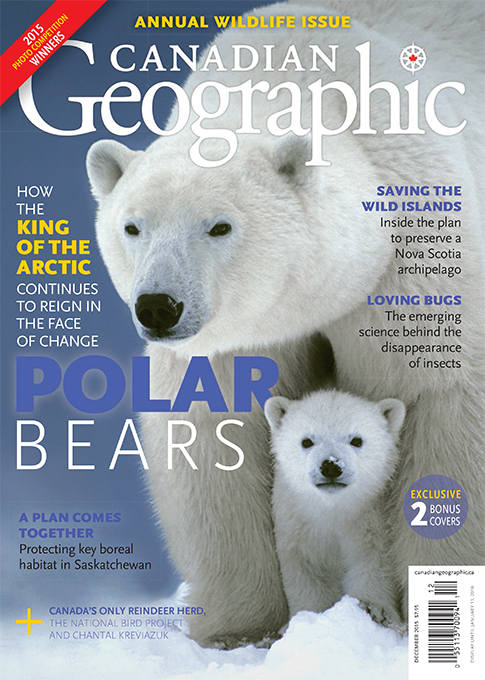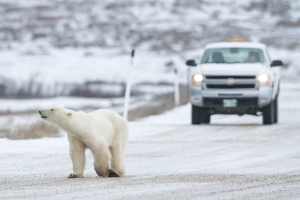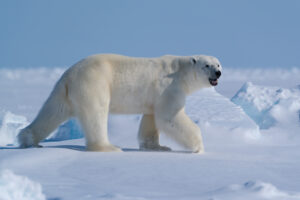Every year in November tourists flock to Churchill, Manitoba to see polar bears. Once the Bay freezes over the bears are finally able to venture out on the ice and enjoy a well deserved seal buffet. At this same time, 60 kilometers south of Churchill in Wapusk National Park, female polar bears are giving birth to one to three cubs no bigger than a one-pound stick of butter.
In February and March, these little fluff balls are about the size of a small dog. Up to this point they have been living in a snow den about eight to ten feet below the snow’s surface. When they are ready, mom pokes her head through the top of the den and the babies get to experience the world for the first time.
Photographers like myself wait 100 meters away, hoping to witness this amazing spectacle. Sometimes we wait eight hours a day for days on end staring at a hole in the snow to no avail. On those days, -40 C to -50 C temperatures are very challenging. When we do see the polar bear moms and babies they warm our hearts and we almost don’t notice the cold temperatures. We must be very cautious, however, as -50 C temperatures can burn exposed skin in seconds and can cause frostbite in just a few minutes.
The extreme temperatures can make the photography difficult as well. Camera issues are very common. Our camera batteries can die quickly in the extreme cold and need to be rotated frequently. Our LCD camera screens and viewfinders frost over and our shutters and focusing systems slow down considerably.
A photography safari in the arctic is not like the five star African safaris where it’s warm and there is game everywhere you look, and at night you retire to an air-conditioned lodge or fancy luxury tent. In the arctic, people can go an entire safari without seeing any animals. We have no running water and we share a small room with three strangers. Still, there aren’t many animal sightings that I have seen in the wild that are cuter, more entertaining to watch and more rewarding than seeing polar bear cubs coming out of their den.
Once the polar bear moms and cubs leave the den, they walk for a couple of hours, then nurse and rest. The cubs snuggle into what looks like the warmest arctic blanket imaginable. Mom cradles them and uses her body to shelter them from the cold. When the cubs have had enough rest the babies will wake up and play. Mom often turns into a jungle gym and the cubs play on her until she is ready to get up and continue on another leg of their journey. Walk, nurse, rest, play and repeat. This routine continues on for the next 60 or so kilometers until mom can get to the Bay to finally enjoy the seal buffet with the other polar bears.
See more of Greg Harvey’s work at www.harveywildlifephotography.ca
All photos: Greg Harvey















